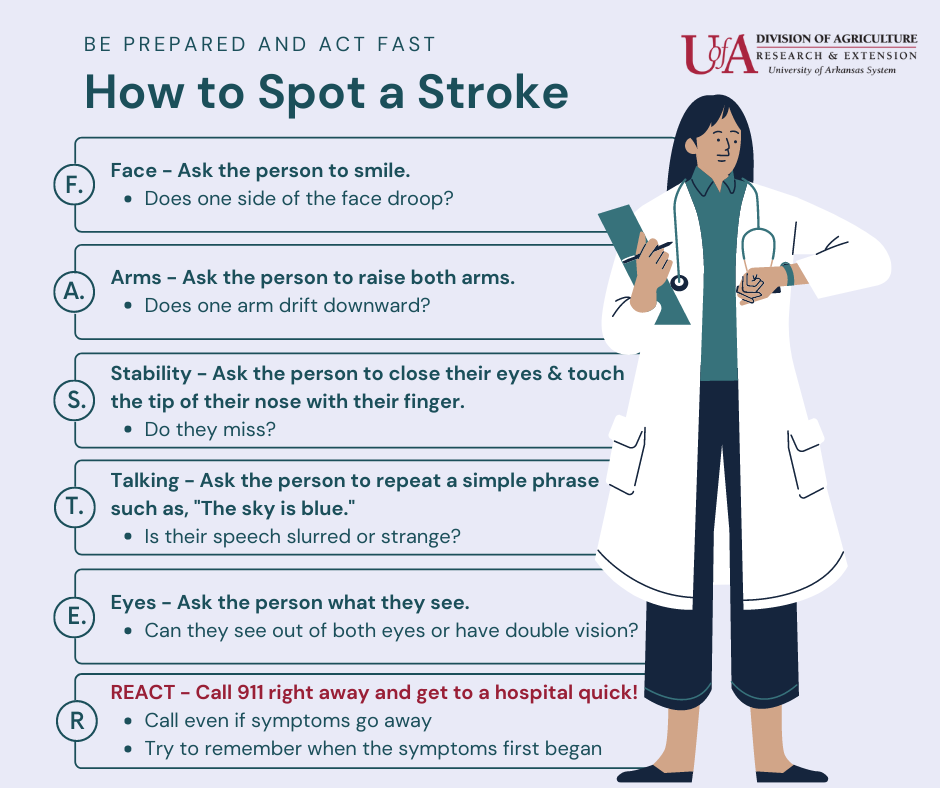May is National Stroke Awareness Month
At Home with UAEX
Learn from the best Extension Educators on being at home with UAEX!
May is National Stroke Awareness Month
by Original Post by Heather Wingo | Adapted for blog by Katie Cullum
Someone in the United States has a stroke every 40 seconds and every 4 minutes, someone dies of a stroke. In 2009, 34% of people hospitalized for stroke were less than 65 years old.
A stroke occurs when something blocks blood supply to part of the brain or when a blood vessel in the brain bursts. In either case, parts of the brain become damaged or die. A stroke can cause lasting brain damage, long-term disability, or even death.
The brain controls our movements, stores our memories, and is the sources of our thoughts, emotions, and language. The brain also controls many functions of the body, like breathing and digestion. To work properly, your brain needs oxygen. Although your brain makes up only 2% of your body weight, it uses 20% of the oxygen you breathe. Your arteries deliver oxygen-rich blood to all parts of your brain. If something happens to block the flow of blood, brain cells start to die within minutes because they can’t get oxygen. This causes a stroke.
There are two types of stroke:
1.) An ischemic stroke occurs when blood clots or other particles block the blood
vessels to the brain. Fatty deposits called plaque can also cause blockages by building
up in the blood vessels.
2.) A hemorrhagic stroke occurs when a blood vessel bursts in the brain. Blood builds
up and damages surrounding brain tissue.
During a stroke, every minute counts! Fast treatment can lessen the brain damage that stroke can cause. By knowing the signs and symptoms of stroke, you can take a quick action and perhaps save a life – maybe even your own.
Signs of stroke in men and women include the following:
- Sudden numbness or weakness in the face, arm, or leg, especially on one side of the body.
- Sudden confusion, trouble speaking, or difficulty understanding speech.
- Sudden trouble seeing in one or both eyes.
- Sudden trouble walking, dizziness, loss of balance, or lack of coordination.
- Sudden severe headache with no known cause.
Call 9-1-1 right away if you or someone you know has any of these symptoms.
Acting F.A.S.T.E.R. can help stroke patients get the treatments they desperately need. The stroke treatments that work best are available only if the stroke is recognized and diagnosed within 3 hours of the first symptoms. Stroke patients may not be eligible for these if they don’t arrive at the hospital in time.
If you think someone may be having a stroke, act F.A.S.T. and do the following simple test:

- F-Face: Ask the person to smile. Does one side of the face droop?
- A-Arms: Ask the person to raise both arms. Does one arm drift downward?
- S-Stability: Ask the person to close their eyes & touch the tip of their nose with their finger? Do they miss?
- T-Talk: Ask the person to repeat a simple phrase such as, “The sky is blue.” Is the speech slurred or strange?
- E-Eyes: Ask the person what they see. Can they see out of both eyes or have double vision?
- R-REACT: Call 9-1-1 right away and get to a hospital quick! Call even if the symptoms go away and try to remember when the symptoms first began.
Note the time when any symptoms first appear. This information helps health care providers determine the best treatment for each person. Do not drive to the hospital or let someone else drive you. Call an ambulance so that medical personnel can begin life saving treatment on the way to the emergency room.
Stroke treatment begins the moment emergency medical services (EMS) arrives to take you to the hospital. Once at the hospital, you may receive emergency care, treatment to prevent another stroke, rehabilitation to treat the side effects of stroke, or all three.
Once you have had a stroke, you are at high risk for another stroke:
- 1 of 4 stroke survivors has another stroke within 5 years.
- The risk of stroke within 90 days of a TIA may be as high as 17%, with the greatest risk during the first week.
You can prevent stroke by making healthy lifestyle choices like the following:
1.) Healthy Diet – Choosing healthy meal and snack options can help you to prevent stroke. Be sure to eat plenty of fresh fruits and vegetables. Eating foods low in saturated fats, trans fat, and cholesterol and high in fiber can help prevent high cholesterol. Limiting salt (sodium) in your diet can also lower your blood pressure. High cholesterol and high blood pressure increase your chances of having a stroke.
2.) Healthy Weight – Being overweight or obese increases your risk for stroke. To determine whether your weight is in a health range, doctors often calculate your body mass index (BMI). If you know your weight and height, you can calculate your BMI at CDC’s Assessing Your Weight website. Doctors sometimes use waist and hip measurements to measure excess body fat.
3.) Physical Activity – Physical activity can help you stay at a healthy weight and lower your cholesterol and blood pressure levels. For adults, the Surgeon General recommends 2 hours and 30 minutes of moderate-intensity aerobic physical activity, such as a brisk walk, each week. Children and teens should get 1 hour of physical activity every day.
4.) No Smoking – Cigarette smoking greatly increases your chances of having a stroke. If you don’t smoke, don’t start. If you do smoke, quitting will lower your risk for stroke. Your doctor can suggest ways to help you quit.
5.) Limited Alcohol – Avoid drinking too much alcohol which can raise your blood pressure. Men should have no more than two drinks per day and women only one.
Stroke is preventable. Learn the signs of stroke and call 9-1-1 right away if you think someone might be having a stroke. Getting fast treatment is important to preventing death and disability from stroke.
Resources:
Beaumont Health. (2022). Stroke: What You Need to Know. Neurology. Retrieved from https://www.beaumont.org/services/neurology/stroke-what-you-need-to-know
Centers for Disease Control and Prevention. (2022, April 5). Stroke. Retrieved from https://www.cdc.gov/stroke/index.htm
